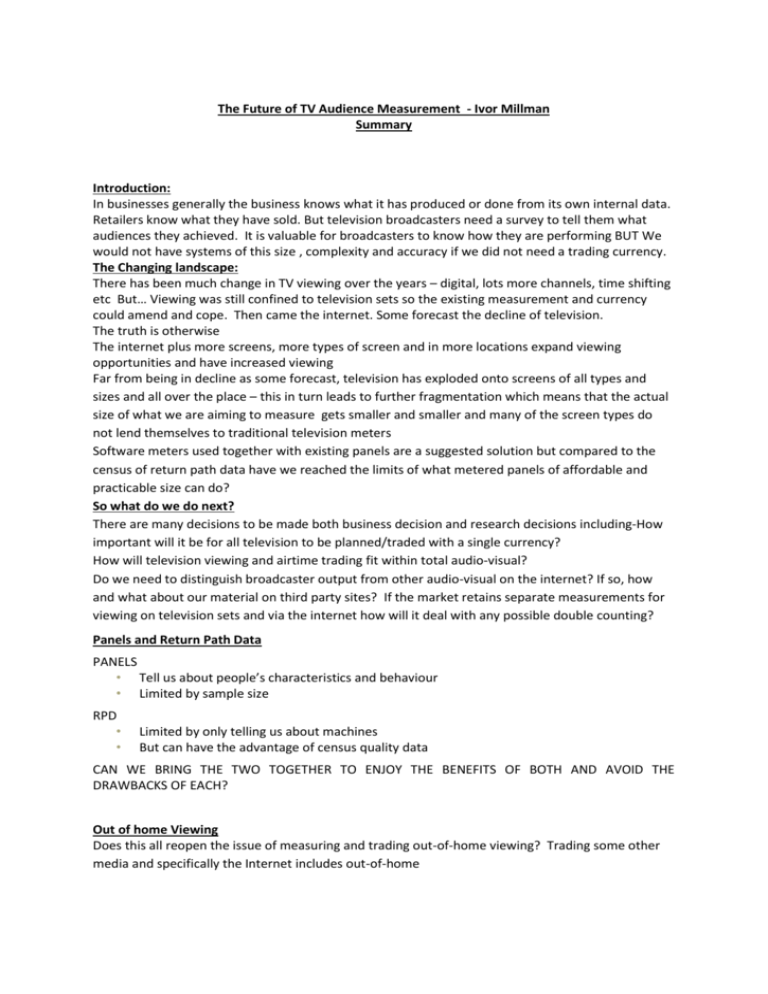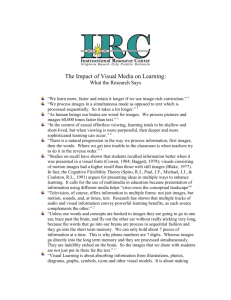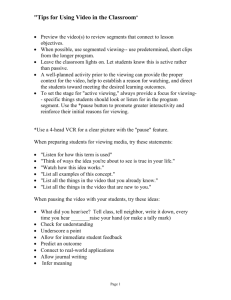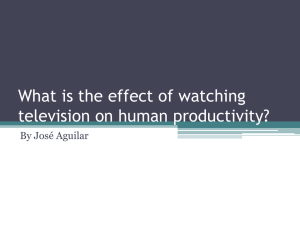The Future of TV Audience Measurement - Summary
advertisement

The Future of TV Audience Measurement - Ivor Millman Summary Introduction: In businesses generally the business knows what it has produced or done from its own internal data. Retailers know what they have sold. But television broadcasters need a survey to tell them what audiences they achieved. It is valuable for broadcasters to know how they are performing BUT We would not have systems of this size , complexity and accuracy if we did not need a trading currency. The Changing landscape: There has been much change in TV viewing over the years – digital, lots more channels, time shifting etc But… Viewing was still confined to television sets so the existing measurement and currency could amend and cope. Then came the internet. Some forecast the decline of television. The truth is otherwise The internet plus more screens, more types of screen and in more locations expand viewing opportunities and have increased viewing Far from being in decline as some forecast, television has exploded onto screens of all types and sizes and all over the place – this in turn leads to further fragmentation which means that the actual size of what we are aiming to measure gets smaller and smaller and many of the screen types do not lend themselves to traditional television meters Software meters used together with existing panels are a suggested solution but compared to the census of return path data have we reached the limits of what metered panels of affordable and practicable size can do? So what do we do next? There are many decisions to be made both business decision and research decisions including-How important will it be for all television to be planned/traded with a single currency? How will television viewing and airtime trading fit within total audio-visual? Do we need to distinguish broadcaster output from other audio-visual on the internet? If so, how and what about our material on third party sites? If the market retains separate measurements for viewing on television sets and via the internet how will it deal with any possible double counting? Panels and Return Path Data PANELS • Tell us about people’s characteristics and behaviour • Limited by sample size RPD • • Limited by only telling us about machines But can have the advantage of census quality data CAN WE BRING THE TWO TOGETHER TO ENJOY THE BENEFITS OF BOTH AND AVOID THE DRAWBACKS OF EACH? Out of home Viewing Does this all reopen the issue of measuring and trading out-of-home viewing? Trading some other media and specifically the Internet includes out-of-home What are the the research agencies doing? • All are working on how to measure audio-visual on non-television screens and how to integrate that with TAM data • Software meters-issues with types of equipment/delivery such as apps • Broadcasters need to ‘mark’ output • How to personalise RPD • How to integrate data What are other countries doing? Europe UK – BARB - Virtual meter rolling out. Project Dovetail – Panel plus RPD – WIP Sweden – MMS - Reporting TV data alongside on-line. Currently creating a currency for “moving images” – testing underway . Implementation target 2016. Measurement technique – Panel plus RPD. Germany – AGF - Linking TAM panel with software meter panel – target 2014 Netherlands is a Google panel country – the project is initiated and funded by Google and combines TV + online+ demographics + purchasing - WIP What Market are we in? • Are we still television? • Or are we now audio-visual? • Are we now/in the future in the same market as anything else of broadcast quality audiovisual on a screen or of anything audio-visual on a screen? • Do we design a measurement that meets our needs and explicitly seeks to exclude others ? • Or do we design a measurement that meets our needs but could also meet those of others (as in the past)? Will the integration of RPD and Panel data happen? Many issues still to be overcome such as: • Trading relationships and systems already exist separately for viewing on television screens v other screens • CPT/revenue issues- If the measurement of viewing via the internet is perceived as simpler/of lower research technical quality than for viewing on television sets how might that affect the growth and pricing of such airtime. • Planning v trading • Good enough measurement drives out the better. Does a measurement/currency that will do well enough prevent the coming of a better one? (Bad money drives out good.) • Television sets still matter: Their measurement remains the priority • The metered measurement of (larger) screens at home that cannot be hardware metered • The use of external data probably in some statistical combination with panel data • The metered measurement of (smaller) screens that cannot be hardware metered/mobile/out-of-home • The importance of IT expertise • Marking output









